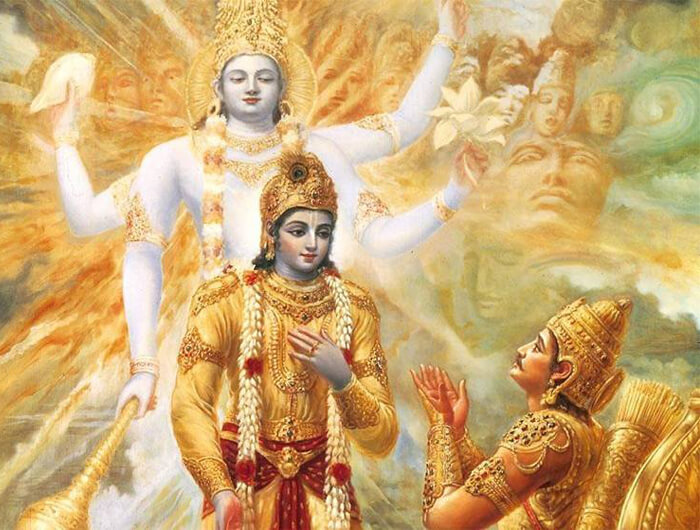Gita Jayanti 2025

Gita Jayanti is celebrated as the birth of Srimad Bhagavad-Gita. It marks the anniversary of the day Lord Krishna gave his immortal message to Arjuna on the battlefield of Kurukshetra. Gita Jayanti is observed in Ekadashi or the eleventh day of Shukla Paksha of the Margashirsha month (November / December).
In 2025 Gita Jayanti will be celebrated on 1st December.
The Bhagavad Gita has 18 chapters and 700 shlokas. Most of it takes place as a dialogue between Krishna and Arjuna; and also discusses important philosophical ideas, particularly the idea of action with detachment. Lord Krishna preached the immortal message to Arjuna, the son of Kunti, and gave him the knowledge of Gita while standing on the battlefield of Kurukshetra on the holy day of Gita Jayanti in Dwapar Yuga.

The 18 chapter names of the Bhagavad Gita
Throughout the Gītā, Krishna helps Arjuna to deepen his relationship of friendship with Krishna by encouraging him to pursue the practice of yoga. Each chapter is called yoga. Yoga is the science of the individual consciousness attaining communion with the Ultimate Consciousness. “Yoga” can mean “connection”, and Krishna makes it very clear that the particular connection to be made, or reaffirmed, is with himself as bhagavān, puruṣottama, the original and ultimate person.
As a yoga practice, the chapter teaches us to become self-critical, recognizing our tendency to slip into the illusion that we are very good, pious, and well-meaning people when we might actually harbor opposite tendencies. Differentiating godly and ungodly assets enables the yogī to consciously cultivate and increase godly assets while shedding and rejecting ungodly tendencies.
So each chapter is a highly specialized yoga revealing the path of attaining realization of the Ultimate Truth. The first six chapters have been classified as the Karma Yoga section as they mainly deal with the science of the individual consciousness attaining communion with the Ultimate Consciousness through actions.
Chapter 1: The Yoga of Arjuna’s Dejection (arjuna-viṣāda-yoga)
Chapter 2: The Yoga of Analysis (sāṅkhya-yoga)
Chapter 3: The Yoga of Action (karma-yoga)
Chapter 4: The Yoga of Knowledge (jñāna-yoga)
Chapter 5: The Yoga of Renunciation (sannyāsa-yoga)
Chapter 6: The Yoga of Meditation (dhyana-yoga)
The middle six chapters have been designated as the Bhakti Yoga section as they principally are pertaining to the science of the individual consciousness attaining communion with the Ultimate Consciousness by the path of devotion.
Chapter 7: The Yoga of Wisdom (vijnana-yoga)
Chapter 8: The Yoga of Liberating Spirit (tāraka-brahma-yoga)
Chapter 9: The Yoga of Royal and Hidden Knowledge (rāja-vidyā-rāja-guhya-yoga)
Chapter 10: The Yoga of Excellence (vibhūti-yoga)
Chapter 11: The Yoga of Seeing the Cosmic Form (viśva-rūpa-darśana-yoga)
Chapter 12: The Yoga of Devotion (bhakti-yoga)
The final six chapters are regarded as the Jnana Yoga section as they are primarily concerned with the science of the individual consciousness attaining communion with the Ultimate Consciousness through the intellect.
Chapter 13: The Yoga of Distinguishing Matter from Spirit (prakṛti-puruṣa-viveka-yoga)
Chapter 14: The Yoga of the Threefold Modalities (guṇa-traya-vibhāga-yoga)
Chapter 15: The Yoga of the Ultimate Person (puruṣottama-yoga)
Chapter 16: The Yoga of Differentiating Godly and Ungodly Assets (daivāsura-sampad-vibhāga-yoga)
Chapter 17: The Yoga of Differentiating Threefold Faith (śraddhā-traya-vibhāga-yoga)
Chapter 18: The Yoga of Liberation (mokṣa-yoga)
Rituals of Gita Jayanti
The day is celebrated by Lord Krishna devotees (followers of Sanatana Dharma). The day falls on Ekadashi (Ekadashi fasting is the eleventh day of the moon and Amavasya) when people keep fast and perform pujas and organize bhajans. In places where this festival is celebrated grandly, stage play and Gita chanting competitions are organized to show children as a way to encourage their interest to read Gita.
The main purpose of celebrating Gita Jayanti is to recall the words of Gita and to apply them in our daily life. The Gita does not advocate giving up on life and retiring to forests. On the other hand, it enables you to enjoy life to the fullest while focusing on inner enrichment.
The Gita is one of the most beautiful pieces of philosophy ever written. It shines as the beacon light of knowledge, inspiring millions to tread the path of Dharma.
Let us bow before Lord Krishna to pray for universal peace and happiness. May no one suffer from illness, and may there be no hatred. Here’s wishing you a very blissful Gita Jayanti.
Suggested Read: Geeta Saar
108 Important Slokas Of Bhagavad Gita
